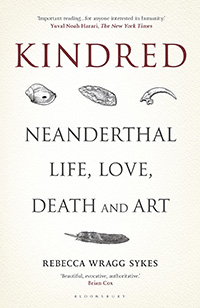 Rebecca Wragg Sykes, Kindred: Neanderthal Life, Love, Death and Art (New York: Bloomsbury, 2020), 400pp.
Rebecca Wragg Sykes, Kindred: Neanderthal Life, Love, Death and Art (New York: Bloomsbury, 2020), 400pp.
Ever since we discovered the fossilized remains of Neanderthals in 1856 in a German cave, they have been the victims of popular stereotypes. There's the cave man trope that imagines a bearded brute "bent over, absent-mindedly hefting a wooden club, and with decidedly ape-ish pelt and feet." No wonder they went extinct! A more contemporary distortion exclaims they were just like us: "not so dumb after all!"
Rebecca Sykes's magisterial volume rejects these caricatures in her complex and fascinating history of what we have learned about Neanderthals since 1856. This requires a nuanced approach for a number of reasons. First, Neanderthals were both "recognizable as a kind of human, but decidedly unconventional." They represent "two diverging pathways of being human." Their brains were as big as ours. They interbred with Homo sapiens: "Current data finds between 1.8 and 2.6 per cent Neanderthal DNA in everyone except those of sub-Saharan heritage." So, they were both alike and different, but in exactly what ways is frustratingly unclear.
There's also their enormous range in time, space, environments, and climates. Neanderthals flourished from about 400,000 years ago until their mysterious and hotly debated extinction 40,000 years ago. They lived from the Mediterranean to Siberia and south to Gibraltar. There were clearly "many different ways to be a Neanderthal." Consequently, they bequeathed to us thousands of archaeological sites with perhaps millions of material artifacts. These include mainly "stones and bones," but also so much more: in the last 30 years a "tsunami of new data and complicated interpretations." Scientific advances, especially the analysis of ancient DNA — where "a teaspoon of cave dirt can produce entire genomes," have also revolutionized standard narratives about Neanderthals, and raised further complicated questions.
I would count myself among those who have the deeply human urge to "connect with our ancient past." There's virtually nothing about the Neanderthals that Sykes does not consider: their diet, tools, dwellings, travel, social organization, language, art, story telling, self adornment, and treatment of their dead (burials and cannibalism). The Neanderthals, says Sykes, invite us to ask the "grandest" questions of all, like "who we are, where we came from, and where we might be going." However strange or familiar, the Neanderthals are our "kindred."
Dan Clendenin: dan@journeywithjesus.net


